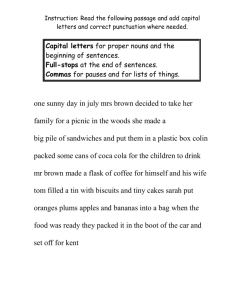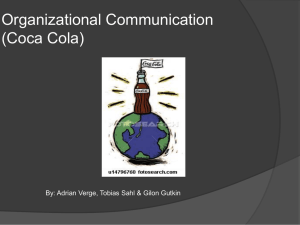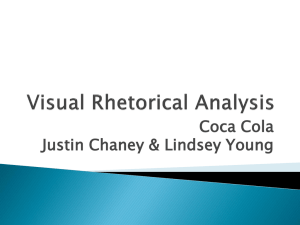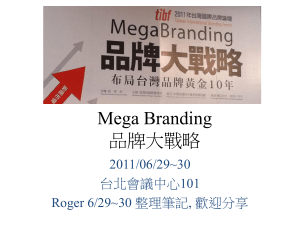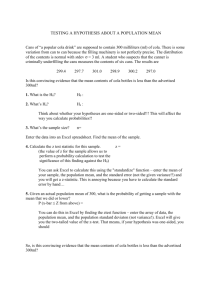Example of Student Work related to Capital Structure Project
advertisement
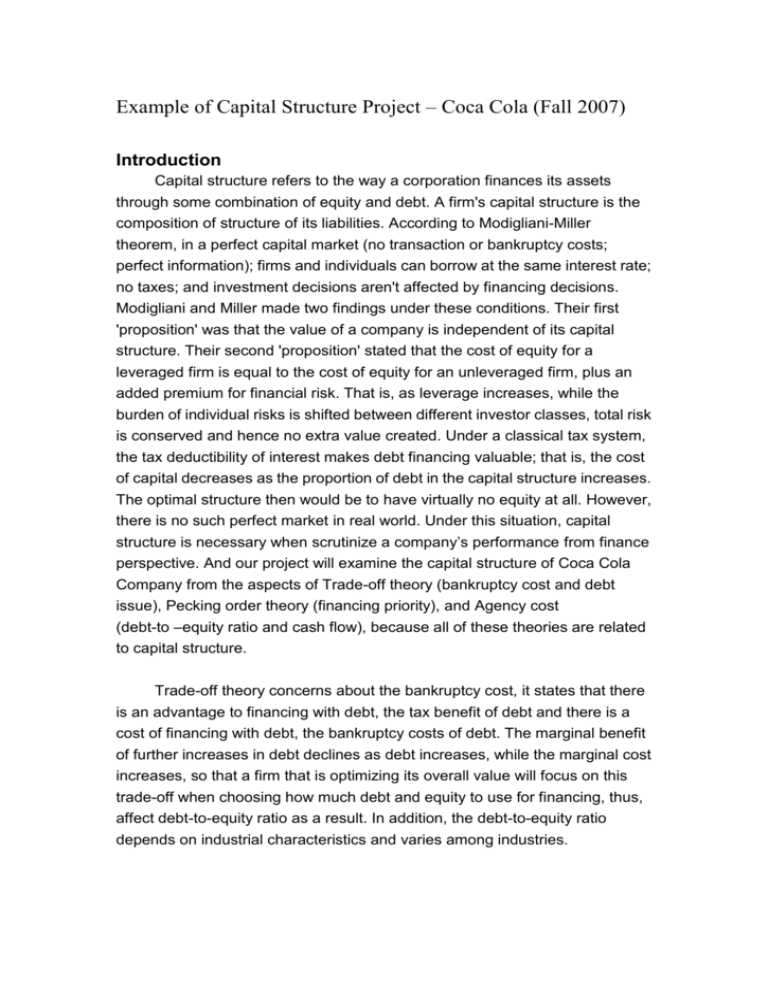
Example of Capital Structure Project – Coca Cola (Fall 2007) Introduction Capital structure refers to the way a corporation finances its assets through some combination of equity and debt. A firm's capital structure is the composition of structure of its liabilities. According to Modigliani-Miller theorem, in a perfect capital market (no transaction or bankruptcy costs; perfect information); firms and individuals can borrow at the same interest rate; no taxes; and investment decisions aren't affected by financing decisions. Modigliani and Miller made two findings under these conditions. Their first 'proposition' was that the value of a company is independent of its capital structure. Their second 'proposition' stated that the cost of equity for a leveraged firm is equal to the cost of equity for an unleveraged firm, plus an added premium for financial risk. That is, as leverage increases, while the burden of individual risks is shifted between different investor classes, total risk is conserved and hence no extra value created. Under a classical tax system, the tax deductibility of interest makes debt financing valuable; that is, the cost of capital decreases as the proportion of debt in the capital structure increases. The optimal structure then would be to have virtually no equity at all. However, there is no such perfect market in real world. Under this situation, capital structure is necessary when scrutinize a company’s performance from finance perspective. And our project will examine the capital structure of Coca Cola Company from the aspects of Trade-off theory (bankruptcy cost and debt issue), Pecking order theory (financing priority), and Agency cost (debt-to –equity ratio and cash flow), because all of these theories are related to capital structure. Trade-off theory concerns about the bankruptcy cost, it states that there is an advantage to financing with debt, the tax benefit of debt and there is a cost of financing with debt, the bankruptcy costs of debt. The marginal benefit of further increases in debt declines as debt increases, while the marginal cost increases, so that a firm that is optimizing its overall value will focus on this trade-off when choosing how much debt and equity to use for financing, thus, affect debt-to-equity ratio as a result. In addition, the debt-to-equity ratio depends on industrial characteristics and varies among industries. For pecking order theory, due to the information asymmetric, companies prioritize their sources of financing (from internal financing to equity) according to the law of least effort, or of least resistance, preferring to raise equity as a financing means “of last resort”. Hence internal funds are used first, then debt is issued, and equity is issued as last step. The agency cost is mainly related to the conflict between bondholders and stockholders. Firstly, as D/E ratio increases, management has an increased incentive to undertake risky projects. This is because if the project is successful, stockholders get all the upside, whereas if it is unsuccessful, bondholders get all the downside. If the projects are undertaken, there is a chance of firm value decreasing and a wealth transfer from bondholders to stockholders. Secondly, when debt is risky, the gain from the project will accrue to bondholders rather than stockholders. Thus, management has an incentive to reject positive NPV projects, even though they have the potential to increase firm value. How is agency cost related to optimal capital structure? What sort of firms will have more debt, according to agency theory? You started off well; but you don’t relate all these things to Coca-Cola. The following is our analysis of Coca Cola’s capital structure. Debt-to-equity ratio and Financial Strategies For coca cola, the following is our calculation of its debt-equity ratio: We used the amount of long term debt and shareholders' equity to find Coca Cola’s debt- equity ratio by using Excel function. The result is shown below table. For example, debt-equity ratio in 2002 was equal to 0.228898 which are calculated by 2701/11800. Debt-Equity Ratio Total Long Term Debt Value of Equity Debt-Equity Ratio 2006 2005 2004 2003 2002 1314 1154 1157 2517 2701 16920 16355 15935 14090 11800 0.07766 0.070559 0.072607 0.178637 0.228898 Also, look at the kinds of securities that Coca Cola has used for financing its operations Source: SEC Annual report of Coca Cola In order to show Coca Cola’s financing methods, the above table presents cash flow from financing activities. Coca Coal is using funds from issuing debt and issuing stocks. Coca Cola believe that their ability to generate cash from operating activities is one of their fundamental financial strengths. They expect cash flows from operating activities to be strong in 2007 and in future years. Accordingly, Coca Cola expects to meet all of their financial commitments and operating needs for the foreseeable future. Also, Coca Cola expect to use cash generated from operating activities primarily for dividends, share repurchases, acquisitions and aggregate contractual obligations. Coca Cola also has used debt financing for their operations. Coca Cola maintains debt levels they consider prudent based on cash flows, interest coverage ratio and percentage of debt to capital. Coca Cola uses debt financing to lower their overall cost of capital, which increases their return on shareowners’ equity. As of December 31, 2006, Coca Cola’s long-term debt was rated ‘‘A+’’ by Standard & Poor’s and ‘‘Aa3’’ by Moody’s, and their commercial paper program was rated ‘‘A-1’’ and ‘‘P-1’’ by Standard & Poor’s and Moody’s, respectively. Coca Cola debt management policies, in conjunction with their share repurchase programs and investment activity, can result in current liabilities exceeding current assets. Issuances and payments of debt included both short-term and long-term financing activities. For instance, on December 31, 2006, Coca Cola had $1,952 million in lines of credit and other short-term credit facilities available, of which approximately $225 million was outstanding. The outstanding amount of $225 million was primarily related to Coca Cola international operations. The issuances of debt in 2006 primarily included approximately $484 million of issuances of commercial paper and short-term debt with maturities of greater than 90 days. The payments of debt in 2006 primarily included approximately $580 million related to commercial paper and short-term debt with maturities of greater than 90 days and approximately $1,383 million of net repayments of commercial paper and short-term debt with maturities of 90 days or less. The below table explains aggregate contractual obligations of Coca Cola from 10k, and this table also shows that Coca Cola’s financing method including short-term loans, borrowings and commercial paper. 1 Refer to Note 8 of Notes to Consolidated Financial Statements for information regarding short-term loans and notes payable. Upon payment of outstanding commercial paper, we typically issue new commercial paper. Lines of credit and other short-term borrowings are expected to fluctuate depending upon current liquidity needs, especially at international subsidiaries. 2 Refer to Note 8 of Notes to Consolidated Financial Statements for a discussion of our liability to CCEAG shareowners as of December 31, 2006. We paid the amount due to CCEAG shareowners in January 2007 to discharge our liability.3 Refer to Note 9 of Notes to Consolidated Financial Statements for information regarding long-term debt. We will consider several alternatives to settle this long-term debt, including the use of cash flows from operating activities, issuance of commercial paper or issuance of other long-term debt.4 We calculated estimated interest payments for long-term debt as follows: for fixed-rate debt and term debt, we calculated interest based on the applicable rates and payment dates; for variable-rate debt and/or non-term debt, we estimated interest rates and payment dates based on our determination of the most likely scenarios for each relevant debt instrument. We typically expect to settle such interest payments with cash flows from operating activities and/or short-term borrowings. 5 The purchase obligations include agreements to purchase goods or services that are enforceable and legally binding and that specify all significant terms, including long-term contractual obligations, open purchase orders, accounts payable and certain accrued liabilities. We expect to fund these obligations with cash flows from operating activities. 6 We expect to fund these marketing obligations with cash flows from operating activities. Therefore, Coca Cola has used many sources to finance their operation activities. First of all, the main fund is their cash from operating earnings. Coca Cola is strongly mentioning about this fact. Other mainly sources are short term borrowing and long term debts. Coca Cola has maintained less amount of stock compared to short term and long term debt. For example, in 2006, Coca Cola had 878 million of stock, but they had 3235 million in terms of short term debt and 1314 million in terms of long term debt. In this case, short term debts include commercial paper, loans and short term borrowing. Also, long term debts include notes. At last, look at changes in Coca-cola’s financing strategy over time, the long-term Debt to Equity ratio has strongly decreased between 2002 and 2004, especially between 2003 and 2004. Since then, the ratio has not changed in a significant way. The variations of the long-term Debt to Equity ratio can be mainly explained by the significant decrease of long-term debts over the period. Between 2003 and 2004, Coca-cola has cut its long-term debts by more than 50 percent. According to Coca-cola, this evolution reflects improved business results and effective capital management strategies. Even though there was a significant change in the long-term Debt to Equity ratio over the period, it is important to notice that this ratio always stays low. Coca-cola carries a long term debt burden of less than one year’s current net earnings. In other words, the earnings for a single year can wipe Coke’s balance sheet squeaky clean. This is consistent with the belief of Mister Warren Buffet, the largest investor in the company at some point, (“The Buffettology workbook” by Mary Buffet and David Clark) who has discovered that the wealth of a company’s asset, tangible and intangible, is in its ability to produce wealth via earnings. According to him, the best of a company’s financial power is in its ability to service and pay off debt out of its net earnings. The appendix 2 and 3 are the charts of long-term debt-to-equity ratio and long-term debt. Very descriptive; you are not planning to do any analysis? of what you see? Asset Explanation Furthermore, as Corporate Finance taught us, the question of a firm’s capital structure is relevant to bankruptcy cost of the firm, which further requires examining what kinds of assets the firm owns. So next we would like to take a deep look at Coca Cola’s assets. First, we want to see the composition of Coca Cola’s assets in terms of tangible versus non-tangible. The table below would help us better understand. Name of Assets Trademarks with indefinite lives Good will 2006 2,045 1,403 Other Intangible Assets 1,687 Percentage in Total Assets 17.14% Ratio of Intangible to Tangible 1:4.84 Note: (units in million except the percentage) 2005 1,946 1,047 2004 2,037 1,097 2003 1,979 1,029 828 12.98% 1:6.70 702 12.25% 1:7.17 981 14.59% 1:5.85 (Source: 10 K of Coca Cola from S.E.C http://www.sec.gov/cgi-bin/browse-edgar?company=&CIK=ko&filenum=&State=&SIC=&owne r=include&action=getcompany) Clearly from this table, the intangible assets play an important role among all Coca Cola’s assets. This should not be surprising, as we all know; Coca Cola is such a firm which derives a great deal of its value from its brand name. Thus, direct bankruptcy cost of the firm should be rather high because some of its assets are not easily divisible and marketable. That is to say, Coca Cola should use less debt in respect that its assets are less liquid. Why do you say that? What assets are you talking about? Why don’t you use some of the extensive facts that you set out above to buttress your arguments here? Second, we also need to see whether Coca Cola’s assets are specialized or not. This is one obvious thing that we don’t need to use figures to prove out. The firm’s major business, beverage, which is very popular worldwide, relies on Coca Cola’s production factory settled in many countries around the world. When the firm wants to select a new location to have a new factory, it will consider whatever will be best for a good beverage, for instance, the water conditions will be tested strictly. And most of its equipments are very specialized for producing such beverage products. Therefore, again in terms of liquidation, Coca Cola’s assets will be less likely to fetch its market value in a short time, resulting in higher expected bankruptcy cost. Hence, the company should use less debt based on this point. Specialized to produce Coca-Cola, as opposed to some other beverages? Really? Sorts of investors of Coca Cola Beside expected bankruptcy cost, agency cost of borrowing is also a factor which should be considered by a firm’s management for decision making on capital structure of the company. Thus, we are interested in what sorts of investors does Coca Cola have. As a large publicly traded corporation, Coca Cola issues both stocks and bonds for its financing needs. There are a big number of investors including private stockholders, institutional stockholders, mutual stockholders and bondholders. Consequently, the conflict could easily exist between stockholders and bondholders, resulting in agency cost when Coca Cola wants to raise fund by borrowing. Furthermore, Coca Cola may want to avoid the agency cost by using less debt. This sound like something you could have written for any company – just substitute the name of that company for Coca-Cola’s! Life cycle In order to determine whether Coca Cola’s current D/E ratio is reasonable, it is necessary to understand the life cycle stage which Coca Cola belong right now. And we calculate Coca Cola’s 6 years revenues conditions to achieve this goal. The following is the result Year Net operating revenue (Unit: million dollars) Growth 6 years average growth 2001 $17,545 2002 2003 2004 2005 2006 $19,394 $20,857 $21,742 $23,104 $24,088 2001-2002 10.539% 2002-2003 7.54% 2003-2004 4.24% 2004-2005 6.26% 2005-2006 4.26% 6.570% From the revenue growth in past sin years, the rates fluctuate between 10.539% and 4.24% with an average rate of 6.57%. It appears that there was no sharply increase in any year but grew in a steady rate. Therefore, we think Coca Cola is a stable growth firm and is in the mature growth stage of life cycle. Furthermore, from dividend table in appendix 4, we can find out that Coca Cola keep increasingly paying dividends from 2001 to 2006 and this situation reflects of Coca Cola’s current mature growth stage in life cycle. Usually, when a company is in rapid expansion or high growth stage, dividend is rarely being paid because of lots of new investments and unstable risk, thus, company still needs plenty of cash. Until the mature growth stage, company has no larger investment which requires lots of cash and has more free cash, and then dividend will likely to be paid. Is this stability because the industry/product is stable? Or is it because Coca-Cola is moribund and is not growing and is not being run properly? Have you looked at other beverage companies? Are they also stable and not growing? Can you really conclude that there are no new profitable investments available in this industry? Optimal Structure At last, we try to estimate the performance of Coca Cola’s capital structure by using Professor Aswath Damodaran’s spreadsheet to compute optimal capital structure and comparing Coca Cola’s ratios with the whole industry. For the optimal capital structure, all the numbers are obtained and still available from 10-K of 2006, so the input numbers explanations will not be discussed here, but only the output. The appendix 5 only shows the summary result and please refers to the Excel spreadsheet attaching with this document for detail information (File name: Capital Structure). In order to determine Coca Cola’s performance, the appendix 6 and 7 show the numbers of industry and leader in each category. The result reveals that: 1. Coca Cola’s D / (D+E) ratio is much lower than optimal, however, it is not a bad thing when a company has low debt. It just implies that Coca Cola has more credit to issue debts if it wants. Why is it not a bad thing? It is better to leave value untapped? 2. Coca Cola’s beta is a little lower than optimal beta. What’s an optimal beta? However, Coca Cola’s current beta is just equal to current industry beta, which means Coca Cola is moving with market movements and exactly match! The following is the link of all industries beta look up. ( http://pages.stern.nyu.edu/~adamodar/New_Home_Page/datafile/Betas.h tml ) 3. Although Coca Cola ha lower cost of equity than optimal, it’s WACC (Weighted Average Cost of Capital) is higher than optimal. According to the formula, it implies that Coca Cola may have higher cost of debt. Thus, it helps explain Coca Cola’s recent finance strategies to keep lowing long-term debt. 4. This is a surprising finding because Coca Cola has stable growth rate and kept paying dividends, but the last four numbers show that Coca Cola’s firm value and current stock price is underestimated for 17,399 million and 7.41 dollars for perpetual growth. And under the situation, company usually does not issue stock because of no benefit, thus, it helps explain Coca Cola’s finance strategies to keep repurchasing stocks while issues less stocks year by year. 5. At last, comparing with the whole industry and leader in each category, Coca Cola performs pretty well and is above average. Under this situation, we think Coca Cola is a financially healthy firm. Conclusion Based on our analysis above, we have two recommendations for Coca Cola. 1. As mention in trade-off theory with the advantages of issuing debts, we suggest Coca Cola to issue more debt and issue less equity because of tax benefit. However, Coca Cola also has a problem with higher cost of debt and this is the problem Coca Cola has to fix in order to issue more debt. 2. By looking at the life cycle, Coca Cola is in mature growth stage and is on the way to declining stage. This fact may help explain the underestimation of its stock price; investors forecast that Coca Cola will decline in the future, and unwilling to invest. Instead, investors prefer to invest in a potential company which is in rapid expansion or high growth stage, even though investors cannot get any money back now. They expect the stock price will increase sharply in the future, and then sell it to gain more. Under this situation, we recommend that Coca Cola has to introducing some innovative products in order to bring it backward to rapid expansion or high growth stage and attract investors. By doing so, we think Coca Cola has enough free cash flow (because only companies with enough free cash and do not have big projects with positive NPV to invest will attempt to pay dividends as substitutes for debt) and credit to issue debts (the low long-term debt to equity ratio) to invest in this kind of huge project. Otherwise, Coca Cola will lose its competitiveness in the future. You cannot investigate capital structure without getting your hands dirty. Damodaran’s spreadsheet is not an automatic machine that generates optimal capital structures. Did you input the right data? Are the assumptions appropriate? Does it take all relevant information into account? Appendix 1. Coca Cola - annual reports of previous 5 years Annual Balance Sheet 2006 2005 2004 2003 2002 In Millions of U.S. Dollars 12/31/06 12/31/05 12/31/04 12/31/03 12/31/02 (except for per share Reclassified Restated Restated items) 12/31/06 12/31/05 12/31/03 Cash & Equivalents 2,440 4,701 6,707 3,362 2,260 150 66 61 120 85 Cash and Short Term Investments 2,590 4,767 6,768 3,482 2,345 Trade Accounts Receivable, Gross 2,650 2,353 2,313 2,152 2,152 (63) (72) (69) (61) (55) 2,587 2,281 2,244 2,091 2,097 Inventory - Finished Goods 548 512 -- -- -- Inventory - Raw Materials 923 704 -- -- -- Inventories - Other 170 163 -- -- -- 1,641 1,379 1,420 1,252 1,294 Short Term Investments Provision for Doubtful Accounts Total Receivables, Net Total Inventory Prepaid Expenses 1,623 1,778 1,849 1,571 1,616 Total Current Assets 8,441 10,205 12,281 8,396 7,352 Buildings 3,020 2,692 2,822 2,615 2,332 495 447 479 419 385 7,889 6,739 6,618 6,588 6,284 507 306 230 -- -- Property/Plant/Equipment - Gross 11,911 10,184 10,149 9,622 9,001 Accumulated Depreciation (5,008) (4,353) (4,058) (3,525) (3,090) Property/Plant/Equipment - Net 6,903 5,831 6,091 6,097 5,911 Goodwill, Net 1,403 1,047 1,097 1,029 876 Intangibles, Net 3,732 2,774 2,739 2,960 2,582 LT Invt. - Affiliate Comp. 6,310 6,562 5,897 5,224 4,737 LT Investments - Other 473 360 355 314 254 Long Term Investments 6,783 6,922 6,252 5,538 4,991 Other Long Term Assets 2,701 2,648 2,981 3,322 2,694 29,963 29,427 31,441 27,342 24,406 929 902 -- -- -- -- -- 4,403 4,058 3,692 Accrued Expenses 4,126 3,591 -- -- -- Notes Payable/Short Term Debt 3,235 4,518 4,531 2,583 2,475 Curr. Port. LT Dbt/Cap Ls. 33 28 1,490 323 180 567 797 709 922 994 Total Current Liabilities 8,890 9,836 11,133 7,886 7,341 Total Long Term Debt 1,314 1,154 1,157 2,517 2,701 Total Debt 4,582 5,700 7,178 5,423 5,356 Deferred Income Tax 608 352 402 337 304 Other Liabilities, Total 2,231 1,730 2,814 2,512 2,260 Total Liabilities 13,043 13,072 15,506 13,252 12,606 Common Stock 878 877 Land/Improvements Machinery/Equipment Construction in Progress Total Assets Accounts Payable Payable/Accrued Other Current Liabilities, Total 875 874 873 Additional Paid-In Capital Retained Earnings (Accumulated Deficit) Treasury Stock Common 5,983 5,492 33,468 31,299 (22,118) 4,928 4,395 3,857 29,105 26,687 24,506 (19,644) (17,625) (15,871) (14,389) Other Equity, Total (1,291) (1,669) (1,348) (1,995) (3,047) Total Equity 16,920 16,355 15,935 14,090 11,800 Total Liabilities & Shareholders’ Equity 29,963 29,427 31,441 27,342 24,406 2,318 2,369 2,409 2,442 2,471 1,193 1,138 1,091 1,053 1,020 Total Common Shares Outstanding Trsy. Shrs-Comm. Primary Iss. Sources: Reuter, SEC 10K 2. & 3. Lomg-term Debt to Equity Ratio 0,25 0,2 0,15 Debt to Equity Ratio 0,1 0,05 0 2002 2003 2004 2005 2006 Long-term debt 3 2,5 2 1,5 Long-term debt 1 0,5 0 2002 2003 2004 2005 2006 4. Dividends period: 1/1/2001 ~ 12/31/2006 Date Open High Low Close 29-Nov-06 $ 0.31 Dividend 13-Sep-06 $ 0.31 Dividend 13-Jun-06 $ 0.31 Dividend 13-Mar-06 $ 0.31 Dividend 29-Nov-05 $ 0.28 Dividend 13-Sep-05 $ 0.28 Dividend 13-Jun-05 $ 0.28 Dividend 11-Mar-05 $ 0.28 Dividend 29-Nov-04 $ 0.25 Dividend 13-Sep-04 $ 0.25 Dividend 14-Jun-04 $ 0.25 Dividend 11-Mar-04 $ 0.25 Dividend Volume Adj Close* 26-Nov-03 $ 0.22 Dividend 11-Sep-03 $ 0.22 Dividend 11-Jun-03 $ 0.22 Dividend 12-Mar-03 $ 0.22 Dividend 26-Nov-02 $ 0.20 Dividend 11-Sep-02 $ 0.20 Dividend 12-Jun-02 $ 0.20 Dividend 13-Mar-02 $ 0.20 Dividend 28-Nov-01 $ 0.18 Dividend 13-Jun-01 $ 0.18 Dividend 13-Mar-01 $ 0.18 Dividend * Close price adjusted for dividends and splits. Source: http://finance.yahoo.com 5. Optimal capital structure D/(D+E) Ratio = Assumes constant saving Assumes perpeutal growth RESULTS FROM ANALYSIS Current Optimal 2.30% 20.00% Change 17.70% Beta for the Stock = Cost of Equity = 0.71 7.91% 0.81 8.47% 0.10 0.57% AT Interest Rate on Debt = 2.83% 3.15% 0.33% 7.79% 4.00% $149,728 $149,728 $62.30 $62.30 7.41% -0.38% $157,424 $167,128 $65.58 $69.71 $7,696 $17,399 $3.28 $7.41 WACC Implied Growth Rate = Firm Value (no growth) = Firm Value (Perpetual Growth) = Value/share (No Growth) = Value/share (Perpetual Growth) = 6. Leader Comparison KO VS. INDUSTRY LEADERS Statistic Industry Leader Market Capitalization KO P/E Ratio (ttm) HANS PEG Ratio (ttm, 5 yr expected) CSG Revenue Growth (Qtrly YoY) KO Rank KO 145.57B - 1 / 17 31.76 26.94 2 / 17 4.40 2.36 3 / 17 HANS 38.40% 19.20% 2 / 17 EPS Growth (Qtrly YoY) HANS 73.00% 13.90% 6 / 17 Long-Term Growth Rate (5 yr) JSDA Return on Equity (ttm) HANS Long-Term Debt/Equity (mrq) COKE Dividend Yield (annual) FIZZ 43.4% 9.89% 7 / 17 44.30% 28.91% 4 / 17 7.080 10.90% 0.490 12 / 17 2.20% Source: http://finance.yahoo.com 7. Industry Comparison Industry Statistics Market Capitalization: 224B Price / Earnings: 27.3 Price / Book: -365.0 Net Profit Margin (mrq): 8.3% Price To Free Cash Flow (mrq): -139.5 Return on Equity: 18.1% Total Debt / Equity: 0.7 Dividend Yield: 2.0% Source: http://finance.yahoo.com Reference 1. http://ihome.ust.hk/~nengjiu/JFQApaper04.pdf 2. http://www.econ.hku.hk/workshop/2000/pecking.html 3. http://72.14.205.104/search?q=cache:4P--l9uF0B8J:ocw.mit.edu/NR/rdonl yres/Sloan-School-of-Management/15-402Finance-Theory-IISpring2003/8 99AD5D6-4D5F-41A5-8C6B-1DBAD9C70D0C/0/lec10bwrapupfinancing.p df+trade-off+theory&hl=en&ct=clnk&cd=6&gl=us 4. http://72.14.205.104/search?q=cache:TK-QhhE7pIMJ:faculty.haas.berkele y.edu/hennessy/papers/POST36.pdf+trade-off+theory&hl=en&ct=clnk&cd= 8&gl=us 5. http://72.14.205.104/search?q=cache:gYhmq112RuEJ:www.haas.berkeley .edu/groups/finance/WP/rpf278.pdf+agency+costs&hl=en&ct=clnk&cd=3& gl=us 6. http://papers.ssrn.com/sol3/papers.cfm?abstract_id=243138 7. http://webpage.pace.edu/pviswanath/notes/corpfin/capstruc.html 8. Corporate Finance, 2nd Edition, Aswath Damodaran 9. http://stocks.us.reuters.com/stocks/balanceSheet.asp 10. http://books.google.com/books?id=gzyZq2iJQIQC&printsec=frontcover&dq =buffettology&sig=FsEsi_7MirRDMTQ9QwvbvOyHqAU
